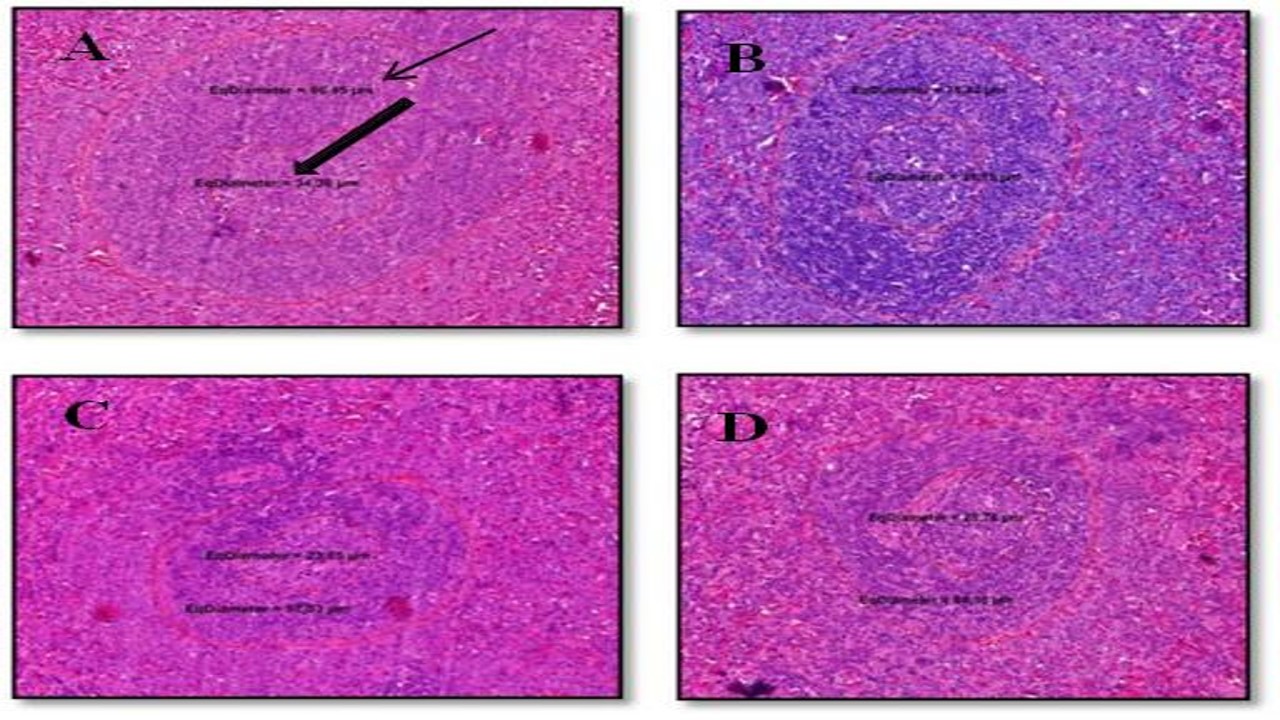The Effect of Administration of Ethanol Extract of Mimosa pudica L. Herbs on The Organ Index and Histology of Spleen of Male Wistar Rats

Downloads
Mimosa Pudica L. is one of the plants that can be used as a traditional medicine which can be used also as analgesic and anti-inflammatory. In the studies of acute toxicity test, Mimosa Pudica L did not cause toxic. This study aimed to investigate the sub-chronic toxicity of Mimosa Pudica L to the spleen index and histology of the spleen of mice which included the observation of follicular diameter and the center of the germ. This test method referred to the OECD 407 (1995) conducted for 28 days with 7 treatment groups and consist of 1 control group , 3 treatment groups and three groups of satellites with a dose of 400 mg / kg , 600 mg / kg and 900 mg / kg. In the satellite group, there was an advance observation for 14 days without any treatment to see whether there was an effect of improvement or not. The results showed that the average value of the index spleen was getting smaller. The data were analyzed with test of homogenety of variances (levene test) showed a similarity of data variance between groups (P > 0.050). The mean value of the index spleen showed there was no significant difference between groups (P > 0.05). The highest mean value of the follicle diameter was in the negative control. Data was analyzed by non- parametric tests Kruskal - Wallis because it did not show the similarity of variance (P < 0.05). The results showed that there was no significant difference between groups (P > 0.05). The satellite group with the dose of 600 mg / kg gave the effect of improvement on the center germinal diameter. The results of the study conveniently indicated that there was no significant difference between groups (P > 0.05). The conclusion of this study was the ethanol extract of the herb Mimosa Pudica L. orally did not leave a distinct meaningful difference or did not affect the spleen index and picture spleen histology.
Azmi, L., Singh, K.M. and Akthar, A.K. 2011, Pharmaceutical and biological on Mimosa pudica Linn, International Journal of Pharmacy and Life Sciences, 2 (11), 1226-1234.
Backer, C.A. dan Brink. B.V.D. 1983, Flora of Java, Vol 1, Groningen: Auspices of Rijksherbarium N.V.P Noordhroff, page 561.
BPOM, 2005. Keputusan Kepala Badan Pengawas Obat dan Makanan Republik Indonesia Nomor hk.00.05.23.3644 tentang ketentuan pokok pengawasan suplemen makanan.
Chaudury, R. R., 1992, Herbal Medicine for Human Health, World Health Organization, New Delhi, 1-2.
Cunny, H. And E. Hodgson, 2004, Toxicity Testing, in: A Textbook of Modern Toxicology, E. Hodgson (Ed), 3rd ed., John Wiley & Sons, Inc., Hoboken, 359-378.
Irawan, B. 2006. Gambaran Histopatologik Limpa Tikus Wistar yang Diinduksi Karsinogenesis Kolon dan Induksi Karsinogenesis Kolon plus DietAmorphophallus Onchopyllus. Artikel Karya Tulis Ilmiah. Semarang: Fakultas Kedokteran Universitas Diponegoro. Hal 8-10.
Jenova R., 2009, ‘Uji Toksisitas Akut Yang Diukur Dengan Penentuan LD50 Ekstrak Herba Putri Malu (Mimosa pudica L. ) Terhadap Mencit BALB/C, Laporan Akhi Penelitian Karya Tulis Ilmiah, Sarjana Fakultas Kedokteran Universitas Diponegoro, Semarang.
Joseph, B., George, J. dan Mohan, J. 2013, Pharmacology and Tradisional Uses Of Mimosa pudica, International Journal of Pharmaceutical Science and Drugs Research, 5(2); 43-44.
Lehman, J. W., 2004, Microscale Operational Organic Chemistry A Problem-Solving Approach to the Laboratory Course, Pearson Education, Inc., New Jersey, 698-699, 703-704.
Smith, J.B. & Mangkoewidjojo, S. 1988. Pemeliharaan, Pembiakan, dan Penggunaan Hewan Percobaan di Daerah Tropis. Universitas Indonesia, Jakarta, pp. 10-16.
Sudjana. 1996. Metoda Statistika. Tarsito, Bandung.
Usman, H. F., Yusro, F., Tavita, E. G. dan Sisillia, L. 2009, Identifikasi Jenis - Jenis Tumbuhan Berkhasiat Obat di Jalan Parit H. Husin 2 Kecamatan Pontianak Tenggara, Vol 3(1).
Zulham. 2009, Penuntun Praktikum Histoteknik. Departmen Histologi, Fakultas Kedokteran.
Copyright (c) 2023 Maria Novita Dolu

This work is licensed under a Creative Commons Attribution-ShareAlike 4.0 International License.
Journal of Basic Medical Veterinary (JBMV) by Unair is licensed under a Creative Commons Attribution-ShareAlike 4.0 International License.
1. The journal allows the author to hold the copyright of the article without restrictions.
2. The journal allows the author(s) to retain publishing rights without restrictions
3. The legal formal aspect of journal publication accessibility refers to Creative Commons Attribution Share-Alike (CC BY-SA).
4. The Creative Commons Attribution Share-Alike (CC BY-SA) license allows re-distribution and re-use of a licensed work on the conditions that the creator is appropriately credited and that any derivative work is made available under "the same, similar or a compatible license”. Other than the conditions mentioned above, the editorial board is not responsible for copyright violation.







 Perhimpunan Dokter Hewan Indonesia
Perhimpunan Dokter Hewan Indonesia








